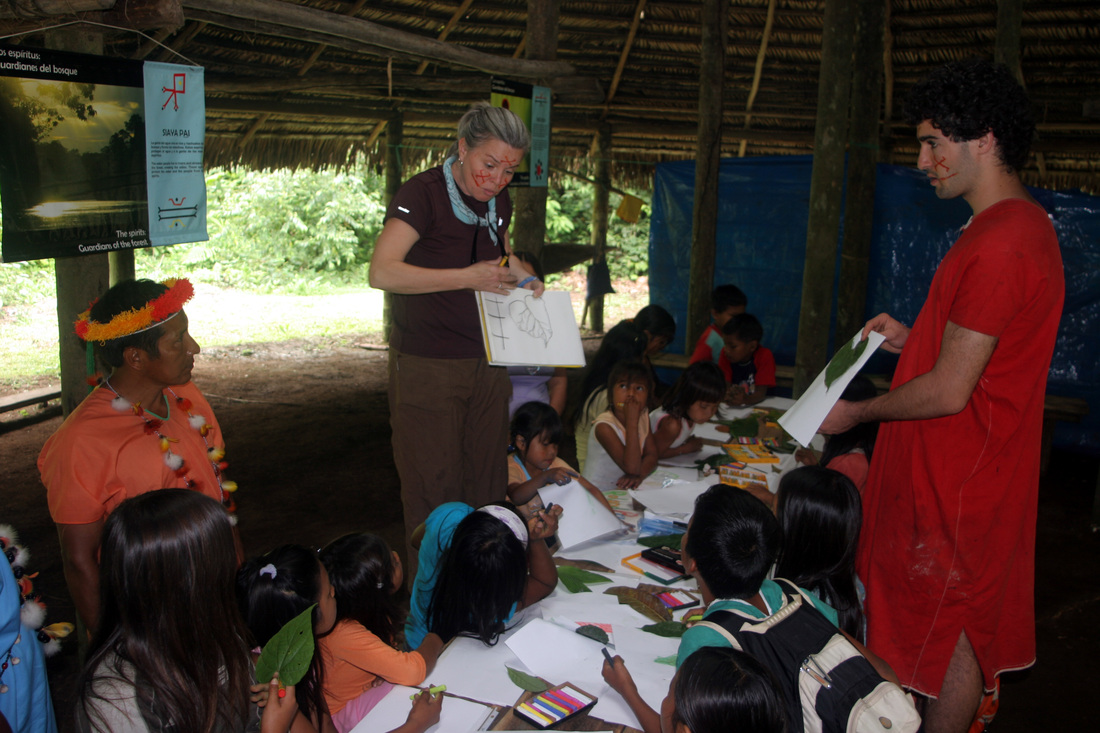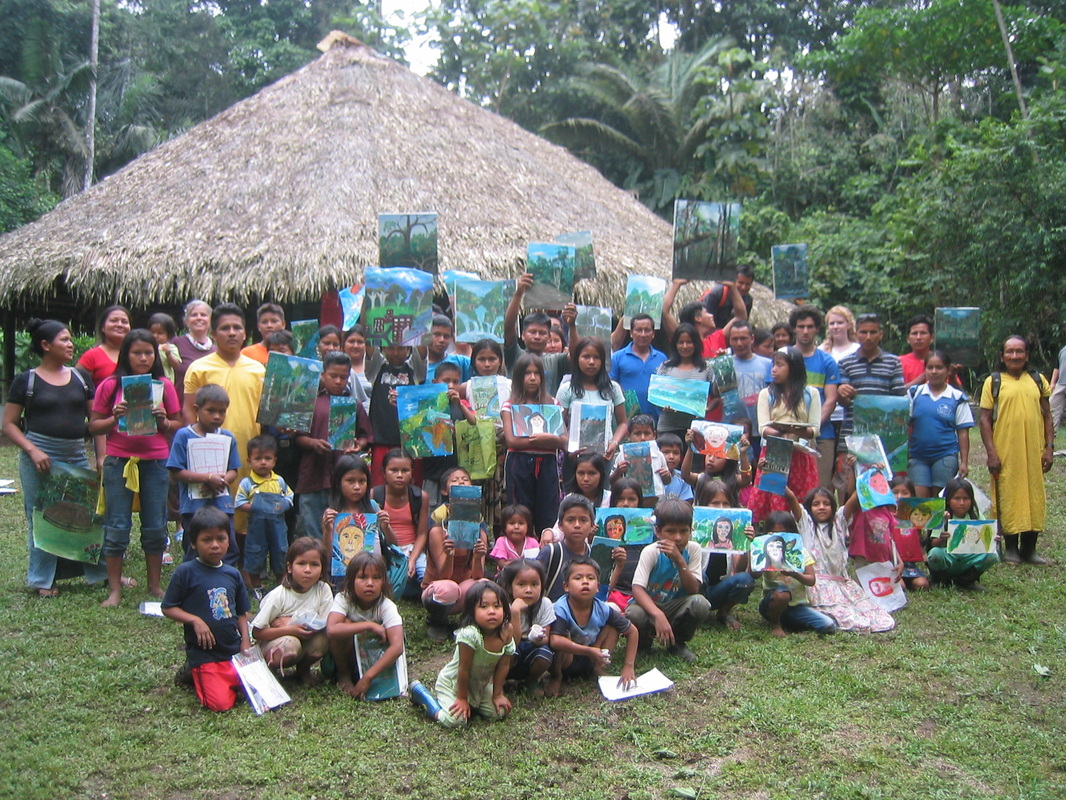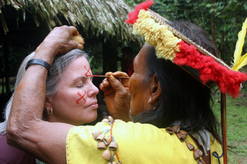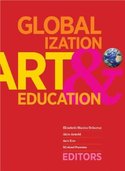Ecuador: Amazonian Secoya CommunityI visited the indigenous Secoya community in the Amazonian region of Ecuador where I lived, learned and painted with the children, families, teachers and Shaman on Secoyan ancestral lands. Led there by my former student, David Poritz (who has since founded Equitable Origin ), I witnessed the ravages of oil contamination left by Chevron/Texaco. My reflection on the self-determination of the Secoya people and the dedication of US youth to join in solidarity to counteract global environmental racism is documented in the NAEA publication Globalization, Art, and Education edited by Elizabeth Delacruz, Alice Arnold, Ann Kuo and Michael Parsons (2009).
My chapter, " The Circulatory System of Oil Contamination, Visual Culture, and Amazon Indigenous Life" starts with these brief statements:
Bode, P. (2009). The Circulatory System of Oil Contamination, Visual Culture, and Amazon Indigenous Life. In E. Delacruz, A. Arnold, A. Kuo, & M. Parsons (Eds.). Globalization, Art, and Education (pp. 269-277). Reston, VA: NAEA.
click here to see art gallery exhibiting the series of paintings I made about my visit to Ecuador - - - - RESOURCES for TEACHING ABOUT CONSEQUENCES OF OIL CONTAMINATION IN INDIGENOUS COMMUNITIES of SOUTH AMERICA Bode, P. (2009). The Circulatory System of Oil Contamination, Visual Culture, and Amazon Indigenous Life. In E. Delacruz, A. Arnold, A. Kuo & M. Parsons, (Eds.). G.L.O.B.A.L.I.Z.A.T.I.O.N, Art, and Education . Reston, VA: NAEA. Aguinda et al. v Texaco. U.S. No. 93 CIV. 7527, 94 CIV. 9266. May 30, (2001). Berlinger, J. (Director & Producer). (2009). CRUDE: The Real price of oil. Entendre films production in association with Radical.media http://www.radicalmedia.com/ and Third Eye Motion Picture Co. http://www.crudethemovie.com/ Bigelow, B. (2000). Oil Companies vs. The Rainforest. Washington, DC: Teaching for Change. Bigleow, B. & Peterson, B. (Eds.). Rethinking Globalization: Teaching for Justice in an Unjust World. Milwaukee: Rethinking Schools Press. Climate Trust, The. CarbonCounter.Org http://www.carboncounter.org/ . CNN. Cable News Network. Hero awards. “Fighting for Social Justice”. (Dec 7, 2007). Retrieved August, 10, 2008 from http://www.cnn.com/video/#/video/living/2007/12/07/heroes.smits.fajardo.cnn?iref=videosearch . Community Economies Project. Department of Human Geography, Research School of Pacific and Asian Studies, ANU. Retrieved September 5, 2008 from http://www.communityeconomies.org/ . Gerlach, A. (2003). Indians, Oil, and Politics: A Recent History of Ecuador. Wilmington, DE:Scholarly Resources. Graham. J., & Members of Community Economies Project. (2001). Imagining and Enacting Noncapitalist Futures. Socialist Review, 28,(3,4) pp. 93-135. Juhasz, A. ( 2008). The Tyranny of Oil: The World's Most Powerful Industry - and What We Must Do to Stop It. New York: William Morrow. Kane, J. (1995). Savages. New York: Random House. Langewiesche, W. (2007, May). Jungle Law.Vanity Fair, 226-236. O’Brien, M. & Proctor, R. (Directors). (2007). Justicia Now! [Documentary motion picture]. Available free on line from Mofilms: motion pictures that deal with important issues. Retrieved September 5, 2008 from http://www.mofilms.org/justicianow/index.html Perkins, J. (2006 ) Confessions of an Economic Hit Man. New York: Penquin/Plume. Posey, D. and Balick, M. (2006) Human Impacts on Amazonia: The Role of Traditional Ecological Knowledge in Conservation and Development. New York: Columbia. Roberts, P. (2005). The End of Oil: On the Edge of a Perilous New World. Boston: Houghton Mifflin. United Nations. Our World in the year 2000. Retrieved September 5, 2008 from http://www.un.org/events/highlights/world2000.htm Vickers, W. (2003). The Modern Political transformation of the Secoya. In N. E. Whitten, Jr. (Ed.), Millenial Ecuador: Critical essays on cultural transformations and social dynamics pp 46-74. Iowa City: University of Iowa Press. Walker, C. (Director & Producer). (1996). Trinkets and Beads. [Motion picture: documentary]. United States: Icarus films. More web resources http://www.amazonwatch.org/ http://www.chevrontoxico.com/ http://www.rainforestfoundation.org/ http://www.sarayaku.com/ http://www.secoya.org/ http://www.vanityfair.com/politics/features/2007/05/texaco200705?currentPage=1 http://humanrights.org/ click image for more information about the book.
Bode, P. (2009). The Circulatory System of Oil Contamination, Visual Culture, and Amazon Indigenous Life. In E. Delacruz, A. Arnold, A. Kuo, & M. Parsons (Eds.). Globalization, Art, and Education (pp. 269-277). Reston, VA: NAEA.
- - - - RESOURCES for TEACHING ABOUT CONSEQUENCES OF OIL CONTAMINATION IN INDIGENOUS COMMUNITIES of SOUTH AMERICA Bode, P. (2009). The Circulatory System of Oil Contamination, Visual Culture, and Amazon Indigenous Life. In E. Delacruz, A. Arnold, A. Kuo & M. Parsons, (Eds.). G.L.O.B.A.L.I.Z.A.T.I.O.N, Art, and Education . Reston, VA: NAEA. Aguinda et al. v Texaco. U.S. No. 93 CIV. 7527, 94 CIV. 9266. May 30, (2001). Berlinger, J. (Director & Producer). (2009). CRUDE: The Real price of oil. Entendre films production in association with Radical.media http://www.radicalmedia.com/ and Third Eye Motion Picture Co. http://www.crudethemovie.com/ Bigelow, B. (2000). Oil Companies vs. The Rainforest. Washington, DC: Teaching for Change. Bigleow, B. & Peterson, B. (Eds.). Rethinking Globalization: Teaching for Justice in an Unjust World. Milwaukee: Rethinking Schools Press. Climate Trust, The. CarbonCounter.Org http://www.carboncounter.org/ . CNN. Cable News Network. Hero awards. “Fighting for Social Justice”. (Dec 7, 2007). Retrieved August, 10, 2008 from http://www.cnn.com/video/#/video/living/2007/12/07/heroes.smits.fajardo.cnn?iref=videosearch . Community Economies Project. Department of Human Geography, Research School of Pacific and Asian Studies, ANU. Retrieved September 5, 2008 from http://www.communityeconomies.org/ . Gerlach, A. (2003). Indians, Oil, and Politics: A Recent History of Ecuador. Wilmington, DE:Scholarly Resources. Graham. J., & Members of Community Economies Project. (2001). Imagining and Enacting Noncapitalist Futures. Socialist Review, 28,(3,4) pp. 93-135. Juhasz, A. ( 2008). The Tyranny of Oil: The World's Most Powerful Industry - and What We Must Do to Stop It. New York: William Morrow. Kane, J. (1995). Savages. New York: Random House. Langewiesche, W. (2007, May). Jungle Law.Vanity Fair, 226-236. O’Brien, M. & Proctor, R. (Directors). (2007). Justicia Now! [Documentary motion picture]. Available free on line from Mofilms: motion pictures that deal with important issues. Retrieved September 5, 2008 from http://www.mofilms.org/justicianow/index.html Perkins, J. (2006 ) Confessions of an Economic Hit Man. New York: Penquin/Plume. Posey, D. and Balick, M. (2006) Human Impacts on Amazonia: The Role of Traditional Ecological Knowledge in Conservation and Development. New York: Columbia. Roberts, P. (2005). The End of Oil: On the Edge of a Perilous New World. Boston: Houghton Mifflin. United Nations. Our World in the year 2000. Retrieved September 5, 2008 from http://www.un.org/events/highlights/world2000.htm Vickers, W. (2003). The Modern Political transformation of the Secoya. In N. E. Whitten, Jr. (Ed.), Millenial Ecuador: Critical essays on cultural transformations and social dynamics pp 46-74. Iowa City: University of Iowa Press. Walker, C. (Director & Producer). (1996). Trinkets and Beads. [Motion picture: documentary]. United States: Icarus films. More web resources http://www.amazonwatch.org/ http://www.chevrontoxico.com/ http://www.rainforestfoundation.org/ http://www.sarayaku.com/ http://www.secoya.org/ http://www.vanityfair.com/politics/features/2007/05/texaco200705?currentPage=1 http://humanrights.org/ |




